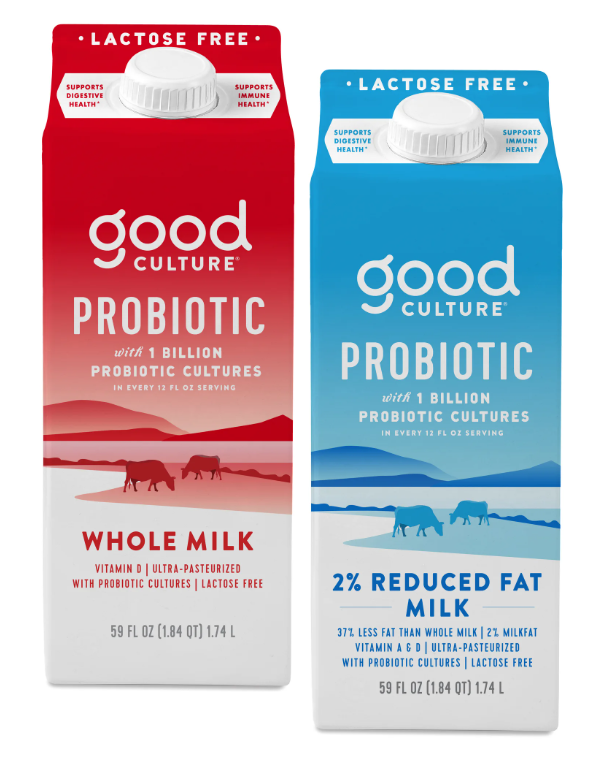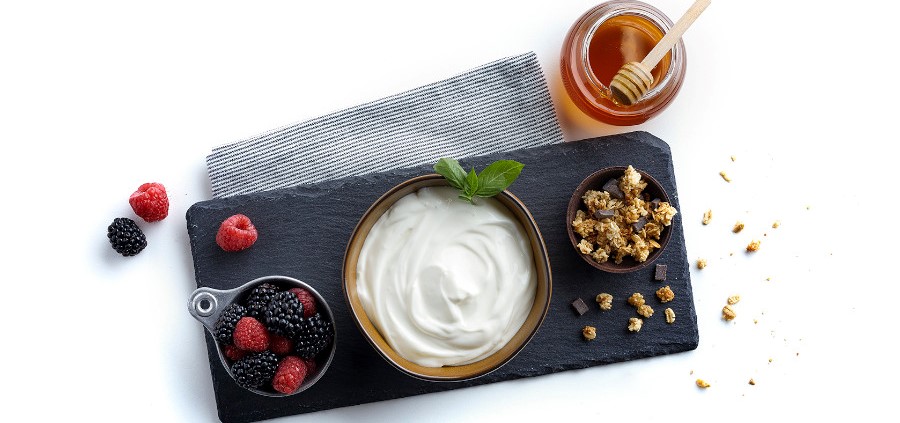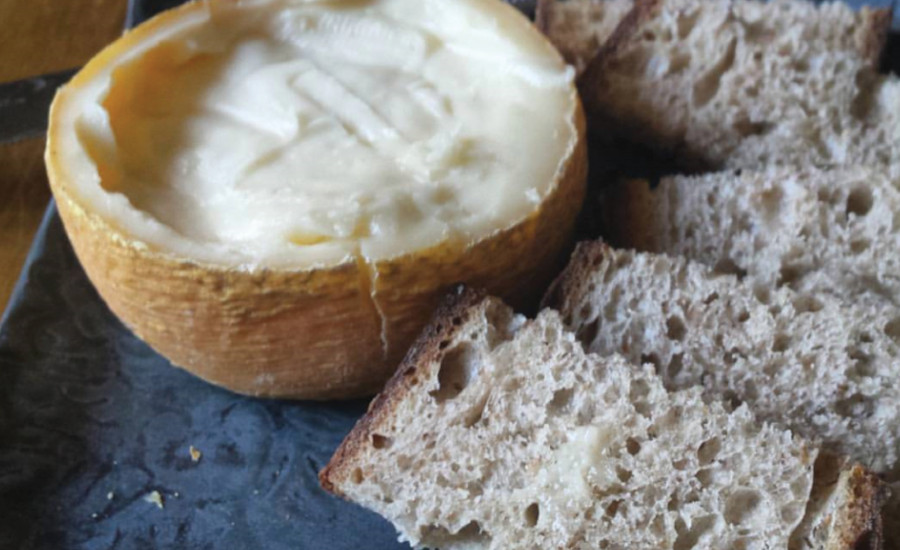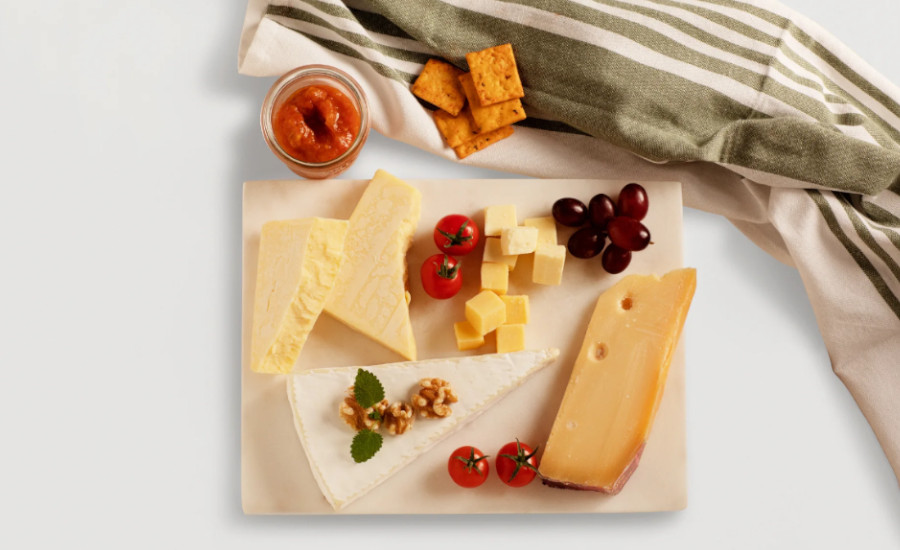Cultures and enzymes facilitate distinctive cheese flavors
Accelerating the acidification of cheese by using the right cultures.

Consumers are reviewing labels, looking for recognizable ingredients that improve taste and texture. Photo courtesy of IFF.
On July 21, 1969, history was forever changed when American astronauts Neil Armstrong and Edwin "Buzz" Aldrin became the first people to walk on the Moon’s surface. Armstrong’s famous quote, “That's one small step for man, one giant leap for mankind” also describes the “leap” dairy processors are making when manufacturing cheese, milk, and fermented dairy products like kefir, yogurt, and cottage cheese. Since ancient times, cultures and enzymes have evolved, leading to a longer shelf life, improved taste and texture, and a cleaner label for dairy.

Clean-label cultures and enzymes are integral to the production of fermented dairy products from sour cream to Parmesan cheese and all the dairy products in between, notes Steve Funk, senior cheese technologist at Nelson-Jameson Inc., Marshfield, Wis.
“Cultures can produce enzymes that impact flavor and texture, and enzymes added separately can add flavor, texture, shelf-life extension, and conversion properties to fermented dairy products,” Funk explains. “Their use is increasing because technological advancements have led to new bioprotective cultures that can replace chemical preservatives. Consumers and national grocery chains are increasingly requesting or requiring preservative-free ingredients, and bioprotective cultures can maintain the integrity of the food product without chemicals.”
Brian Schlatter, Northeast representative of business development at Fromagex, points out that the clean-label concept has led to the advancement and adoption of understanding and developing cultures and enzymes that fall within those categories. “One can look at it as a turning to nature to answer the request at hand,” he says.
While cultures act gradually over time to change flavor development within an aged cheese or facilitate texture development in soft cheese, enzymes act immediately to create change, for example, taking milk from a liquid state to a solid state in cheese production, notes the Rimouski, Canada-based distributor for artisanal and industrial cheese factories.
When combined, “Cultures and Enzymes work together to create the overall product,” Schlatter explains. “For example, in cheese production, the cultures acidify the milk and also bring about flavors while the enzymes do the work to create the solid curd that is then formed into cheese. While cheese can be made without one or the other, and in some cases that is how the product is made, a majority of cheese needs to have both working injunction with each other to create the desired final product.”
The kind of clean label and vegetarian ingredients powering dairy foods also has changed significantly. “Where traditional animal-derived ingredients have become the standard for certain flavor profiles, consumers are now looking for alternatives suitable for vegetarians. One way of doing this is to replace those traditional animal-derived enzymes with microbial and botanical alternatives,” says Christina S. Barsa, director of strategic accounts at New York City-based Enzyme Development Corp.

Used to prevent food spoilage, fermentation has been a crucial part of the dairy industry since ancient times. However, fermenting products and the clean-label benefits they provide were less understood in the past, reports Hannah Keohane, marketing associate at Chr. Hansen, West Allis, Wis.
“We are now able to use bacteria in a way that provides us with food that has reliable and consistent quality,” Keohane explains. “For Chr. Hansen, lactic acid bacterium (LAB) are the ‘good cultures’ that we provide and are necessary for the production of cheese and yogurt. As for enzymes, these are necessary in cheese production in order to coagulate the milk.
“Cultures and enzymes help create a cleaner label for dairy producers by allowing them to leverage the power of these natural solutions,” she continues. “This includes the need for less artificial additives like sweeteners, stabilizers, and preservatives.”
Usage of cultures and enzymes — the behind-the-scenes, clean-label workhorses — are growing because of the ingredients’ ability to develop healthier products and to optimize production in a sustainable way.
Experts note the subtle differences between the two ingredients. “Cultures are well-known for their ability to harness the natural power of fermentation and improve freshness of food by mitigating the effects of contaminants like mold, yeast, and bacteria,” notes Rossana Rodriguez, global marketing director for culture and food enzyme at Leiden, Netherlands-based IFF. “…Meanwhile, enzymes are used widely within the dairy industry to develop tastier, healthier, and consumer-friendly products ... and to maximize yield in a sustainable way.”
Retaining quality, extending shelf life
Experts note that different cheese cultures provide more distinctive cheese tastes, flavors, and textures in finished dairy products. A combination of ingredients improves the cheesemaking speed — accelerating the acidification through use of the right cultures — but also making sure that one preserves the right taste at the end of the processing chain.
To accomplish this, all the steps must be thought out in a reliable, consistent, and predictable way. In addition to producing aged cheese, delivering the right texture also is key for yogurt producers, notes Enzyme Development Corp.’s Barsa.

For example, where cultures can be used to set certain dairy products, such as soft cheese and yogurt, without enzymes, enzymes can be used as a rennet to cause coagulation in cheeses or liquid furcation in enzyme-modified cheeses (EMCs), she says.
Barsa explains that enzymes are often used in combination with cultures when it comes to producing cheese or an EMC. In fact, the combination of the culture and the enzyme gives the dairy product its flavor and texture.
“You can change the enzyme or the culture to manipulate either of those properties. The culture can also be used to help rennet, which is an enzyme, when it comes to cheesemaking,” Barsa explains. “The culture not only gives the cheese a specific flavor profile but it also adjusts the pH of the dairy product, making it an ideal environment for the rennet to work.”
Noting that Lenexa, Kansas-based Corbion has extensive experience using fortification to boost nutritional content in dairy products and the acidification and regulation of pH to extend product shelf life and optimize flavor, Corbion Senior Scientist for Dairy Drew Wunderly explains that because cultures and enzymes are biological systems, they are sensitive to factors such as temperature, pH, time, chemicals and more.
“Cultures and enzymes do not always work in the exact same manner each and every time they are used. For instance, if a small amount of residual sanitizer is in a culture vat, it will have detrimental effects on the speed of the cultures,” Wunderly states. “This can cause a tank that normally ferments in six to eight hours to extend out to eight to 10 hours or longer.
“Storage temperature and working temperatures also affect enzymes and cultures,” he continues. “Trying to minimize any variation and taking special care with the handling and storage is very important to the success of your product. Sanitation above all is key. Any sort of contamination can have disastrous effects on cultured systems.”
Founded more than 100 years ago, Corbion’s expertise arises from its ability to use emulsification to promote the formation and stabilization of emulsions with the goal to create a pleasant mouthfeel and flavor release in dairy drinks, margarines and creamers, the company says.

The “art and science” of making great dairy products is dependent on cultures, which convert carbohydrates into an alcohol or an acid, while producing flavor and texture components (e.g., exopolysaccharides, diacetyl, etc.), Wunderly explains. Enzymes, on the other hand, change one specific part of the food system.
Wunderly cites that the components pivotal to cheese production are lipases that break down fats into fatty acids and the odorless, non-toxic glycerol (a naturally occurring alcohol used as a sweetening solution); lactase, which breaks down lactose into glucose and galactose; and rennet, aka chymosin —the protease enzymes that break down protein — is used in most cheese production to curdle the milk and form the curd.
Cultures and sugar reduction
As consumers seek sugar reduction in products, cultures play a pivotal role in fermented dairy products like yogurt. “Over the years, we have developed a range of modern yogurt cultures that create high viscosity while limiting the post acidification during the yogurt’s shelf life,” Chr. Hansen’s Keohane explains. “This enables producers to reduce the amount of sugar in the formulation while maintaining the associated sensory properties as we found that sugar was used to counterbalance the cultures’ post acidification.”
The global sugar-reduction trend is a major growth driver for the lactose-free segment, particularly since lactose-free products benefit consumers looking to reduce their sugar consumption. “To make lactose-free dairy, lactase enzyme hydrolysis is used to break down the disaccharide lactose, releasing free glucose and galactose molecules that exhibit an increased level of sweetness,” IFF’s Rodriguez explains. “The result is dairy products that consumers perceive as sweeter, though the amount of naturally occurring sugar remains the same. In applications like fruit yogurts or dairy desserts, manufacturers can use this sweeter taste perception to their advantage, reducing added sugar content for a more appealing nutritional profile.”
Additionally, reduced sugar in lactose-free dairy is a major selling point. “In 2022, 11.2% of flavored and sweetened condensed milk launches had 'no added sugar' and 'low reduced sugar' claims, and 46% of German consumers think low sugar is an important attribute in yogurt,” Rodriguez adds.
On the probiotics side, IFF is seeing a greater demand for solutions that aid in digestive health and beyond. Therefore, the company offers HOWARU, which not only aids in digestive wellness, but has wider applications in women’s health, oral health and cognitive health.
“In enzymes, our NURICA transforms the lactose present in milk into galacto-oligosaccharides – a class of dietary prebiotics with beneficial effects on intestinal microbiota and gut barrier function,” Rodrigues says. “This technology has been embraced by dairy producers and consumers as a novel way to incorporate prebiotics in everyday dairy products like yogurts and even fluid milk products.”
On the cultures side, Chr. Hansen developed a unique yogurt patented culture, Sweety, which naturally produces glucose during the fermentation process enhancing the natural sweetness of milk.
Noting that enzymes also can support sugar reduction in dairy products, NOLA Fit is a lactase specifically designed for improved performance in fermented dairy products. The ingredient enhances sweetness through lactose hydrolysis and works cost effectively to accomplish that goal, according to Keohane.
Yet another innovation in the cultures and enzyme space that Chr. Hansen developed and launched is CHY-MAX — the most specific chymosin in today’s dairy market — improves the yield for cheesemakers, allowing processors to make more cheese with less milk, Keohane states.
Providing enzymes to the dairy and food industry for 70 years, Enzyme Development Corp. offers a range of proteases and lipases that can be used for the production of cheese or EMCs, as well as lactase for the production of lactose-free dairy.
Barsa explains that two of the botanical proteases — Thistlezyme and Ficin — are used as renets in cheesemaking. Derived from thistle flowers that historically were used as rennet since ancient times in Spain and Portugal, Thistlezyme was approved for use in cheese processing in the United States and Canada in 2014, Barsa states. Ficin, on the other hand, was used to make artisanal Italian cheese, and the cheesemaker would simply take a twig from the fig tree and put it into milk to clot it.
“Ficin not only has the benefit of being a protease, but it also has naturally occurring lipase activity, which is good for flavor development in cheeses and EMCs,” Barsa says.
IFF offers a wide range of cultures and enzymes for various dairy categories from cheese to fresh fermented dairy and plant-based alternatives. “For example, CHOOZIT VINTAGE, launched in January 2023, is a new range of starter cultures that provide premium, consistent, well-balanced flavor development in cheddar cheese. The cultures promote a smooth, clean-cut texture with no bitterness or crumbliness during the cheese ripening process and from batch to batch,” Rodriguez says.

IFF also extended its range of consumer-friendly label protective culture solutions with HOLDBAC SUSTAIN and XTEND, which Rodriguez points out effectively protect against mold and yeast while delivering better control on post-acidification. Thus, they help keep dairy products fresher for longer by an average of seven additional days, with minimal effects on sensory experience and taste.
Other companies like Fromagex work with the culture producers to distribute ingredients to dairy producers. “We offer a range of products from Chr. Hansen, Danisco and others,” Schlatter says. “New products are being released regularly that work within fresh dairy or cheese production.”
Furthering diversity in cheesemaking
Experts in the dairy industry predict an “incredibly bright” future for the use of cultures and enzymes, but suggest partnering with a trusted resource as “it can be a daunting task trying to troubleshoot or develop new cultured products or implement a new enzyme into production,” Corbion’s Wunderly says. “This is where the customer/supplier relationship is very important. Customers should be able to reach out and receive technical expertise from the experts as we have had a lot of experience with what works, and what doesn’t.”
Industry scientists, product developers, and technical experts are creating new pathways for cultures and enzymes, Nelson-Jameson’s Fund says. “One of these new pathways is the use of non-traditional cultures for unique effects in long-standing cheeses,” he says. “Another is blending cultures and enzymes to enhance product uniqueness, improve marketing and selling opportunities, and create new dairy products within the major categories. The dairy case and its consumers want new, adventurous and non-traditional products.”
Chr. Hansen’s Keohane concurs that there’s still a lot of untapped opportunity in the dairy industry to unlock with the power of microbial solutions. The company also is undergoing a merger with Novozymes to bolster its position as a biotechnology company.
“The synergies between Novozymes and Chr. Hansen boost innovation capabilities for both culture and enzyme development,” she states. “Fermentation can help the dairy industry in many ways: improved quality, cleaner labels, sustainability and better nutrition just to name a few. Chr. Hansen is always looking for new solutions to fulfil the needs of our customers.”
Looking for a reprint of this article?
From high-res PDFs to custom plaques, order your copy today!






